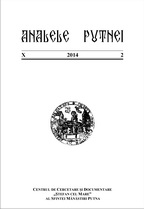Mărturii documentare privind patrimoniul religios al Mănăstirii Putna în perioada 1775–1918 (II)
Written Testimonies about the Religious Patrimony of the Putna Monastery between 1775 and 1918 (II)
Author(s): Monah Alexie CojocaruSubject(s): History
Published by: Centrul de cercetare şi documentare ŞTEFAN CEL MARE
Keywords: Putna Monastery; patrimony; exhibitions; manuscripts; silverware
Summary/Abstract: The fact that starting with the end of the 18th century we have a regularly recorded correspondence in the Putna Monastery allows us to trace back various aspects of its life. One of them is related to the patrimony. The first part of the present paper documents Putna’s participation in various “universal” or regional exhibitions which took place in several cities: Cernăuţi (1855, 1886), Wien (1873, 1887), Kiev (1874) and Bucharest (1906). The monastery sent to these exhibitions a total of 53 items from among the most valuable of its collection. The next section presents new information about several celebrated objects, such as the Humor and Voroneţ Gospel Books, the censor from Stephen the Great, the Buga bell and others. In the third section the author shows what happened to the original marble canopy over the tomb of Stephen the Great, which was replaced by the “România Jună” Society with a sycamore one sometime after 1871. In difficult circumstances the Consistory from Cernăuţi borrowed various things, especially vestments and books, from Putna Monastery for some poor parishes from Bukovina or for the Episcopal chapel. This happened also on special occasions such as the enthronement of Bishop Daniel Vlahovici, on October 26, 1786, or the consecration of the site of the new cathedral from Cernăuţi, on July 3, 1844. On a different occasion the monastery lent nine books to boyar George Hurmuzachi for scientific purposes. The next section is dedicated to the inventories of the monastery, the most important one being that from 1783, which is no longer extant. Beside it, there were other smaller, subsidiary inventories such as those from 1785 and 1789. The author also presents the situation of the monastery’s silverware during the Napoleonic Wars. At that time these objects were taxed, hallmarked and some were borrowed (16 items, on April 15/27, 1810) by the imperial administration. The official documents do not record the return of the latter. The last part of the paper presents other facts related to the patrimony of Putna, such as the reorganization of the archives, the copying of old charters, the making of a new iconostasis for the monastery’s chapel, the forging of a bell in 1865, now lost, the trips to Putna for scientific purposes of Bishop Melchisedec Ştefănescu and Professor Karl Romstorfer.
Journal: Analele Putnei
- Issue Year: 2014
- Issue No: 2
- Page Range: 103-272
- Page Count: 1
- Content File-PDF

